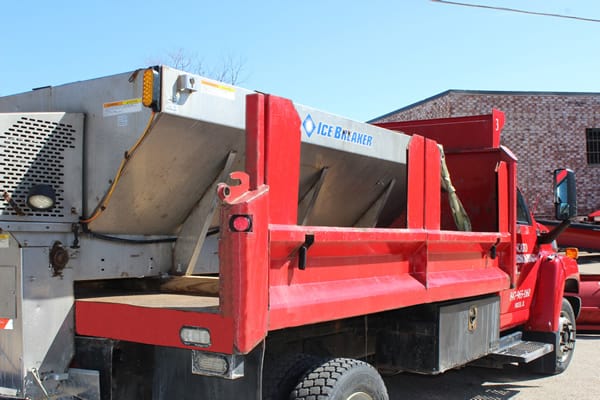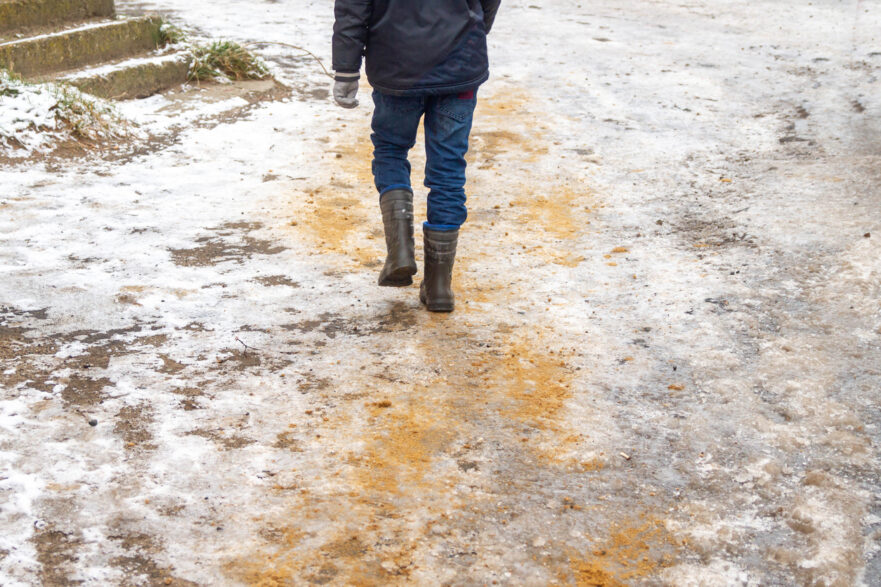Does Sand Melt Ice?
One of the common questions we get about ice management is whether sand is able to melt ice. The short answer to the question is “no”. However, the truth is a little bit more complicated than that. Sand, working together with the sun or friction, can prevent or remove ice build-up. On its own, it can also prevent ice from forming in solid sheets.
Sand, by itself, does not change the freezing temperature of ice. If you add sodium chloride (rock or table salt) like what we have in the ocean, water can remain a liquid at lower temperatures. That is why sea water does not freeze until 28.4°F. If your freezer is at 20° and you throw a whole bunch of salt on ice cubes inside your freezer, you will come back to water instead of ice cubes. If instead, you throw sand on top of ice cubes, you will get nothing more than sand-covered ice cubes hours later.
So, why do we see municipalities and companies use sand on ice? If it doesn’t directly affect ice, can it have an indirect effect?
So, why do we see municipalities and companies use sand on ice?

Ice Management Using Sand
There are several benefits to using sand for ice management. While it doesn’t affect the chemical composition of the water forming into ice, it can make a difference if used in the right way. We will discuss four benefits of using sand in managing ice and snow.
First, sand helps create better traction on the ice. This is especially true in very cold areas where, even with rock salt, the ice will not melt. Sand allows tires to have more friction against the ice for better traction. This is due to the small grains of the sand forming a surface that allows the rubber of your tires or shoe soles to gain traction. The more coarse the sand, the better your traction. As your tires or shoes interact with the sand it causes friction. The grains of sand will rub against each other as you walk or drive across it. As the friction creates heat it will warm the water around it. The friction of the sand against the water on a busy road will also keep the water churning and prevent icing at temperatures near freezing.
A second reason sand is used in ice management is that the sand on top of the ice will absorb the sun’s heat. This will allow the ice to melt more quickly with no further ice treatment. You can see how this works if you observe a leaf sitting on top of snow. The leaf will melt into the snow, leaving a leaf-shaped hole. The leaf, warming up from the sun’s rays, transfers heat to the snow underneath, allowing it to melt more quickly than the snow surrounding the leaf. The same process of heat transference can happen with sand. The darker the grains are, the more sunlight they will absorb and the warmer they will get. Consequently, the snow or ice underneath will warm up and melt.
Why do I sometimes see sand melt ice on winter nights if it doesn’t change the melting point?
If you see sand that appears to melt ice, you are probably looking at a sand & salt blend instead of just plain sand. A common strategy snow and ice management professionals use is mixing sand and rock salt to apply on surfaces. The salt will lower the melting point of the water (as low as 15°for rock salt and even lower for premium road salts). Meanwhile, the friction caused by vehicles driving over sand also impedes the formation of ice. When ice does form, the sand is still there to add traction and the salt still does its work to lower the melting point of the ice.
It Is All About Traction
A third benefit of using sand to improve traction and transfer heat is that it does not add more salt or other chemicals to the freshwater habitats near roads. It does not take much salt to affect freshwater habitats. The changes in the ecological impact can be damaging or destructive to the flora and fauna that call it home. One of the biggest concerns in the Snow and Ice Management industry today is how to reduce salt use to minimize environmental damage. We need to keep the roads safe, but we also need to protect our natural habitats.
The fourth benefit of using sand for ice management is that sand keeps the ice from forming strong bonds that increase slick surfaces. As the sand warms up the ice and sinks it prevents the ice from forming a strong latticework. The ice then has to form around the sand grains. Pressure from people, animals, or vehicles traveling across it will cause the ice to break up.
Why do I sometimes see sand melt ice on winter nights if it doesn’t change the melting point?
If you see sand that appears to melt ice, you are probably looking at a sand & salt blend instead of just plain sand. A common strategy snow and ice management professionals use is mixing sand and rock salt to apply on surfaces. The salt will lower the melting point of the water (as low as 15°for rock salt and even lower for premium road salts).
Meanwhile, the friction caused by vehicles driving over sand also impedes the formation of ice. When ice does form, the sand is still there to add traction and the salt still does its work to lower the melting point of the ice.
Downside Of Sand
As a famous space traveler character once observed, sand gets everywhere. That’s kind of the problem.
The use of sand in ice management can have some unintended and potentially dangerous side effects. Sand can change the ecology of the area around roads and other areas where it is used. This can change the way water drains or damage cover foliage.
Dry sand on roadways can cause additional hazards in the warmer months. Ironically, sand-covered roads can create a hazardous situation where you have less traction than on clean asphalt. Too much sand on a curve can be especially dangerous for motorcycles.

The Brancato Difference
You will find that we have a lot of experience with ice management. It is experience and skill that you can put to work for your business! We have dedicated teams in your area who can handle anything that Mother Nature can dish up.
Give us a call today and find out how we can help your business get through the next ice or snow storm. Our knowledgeable sales team can walk you through it. Our initial consultation and quote is completely free!

